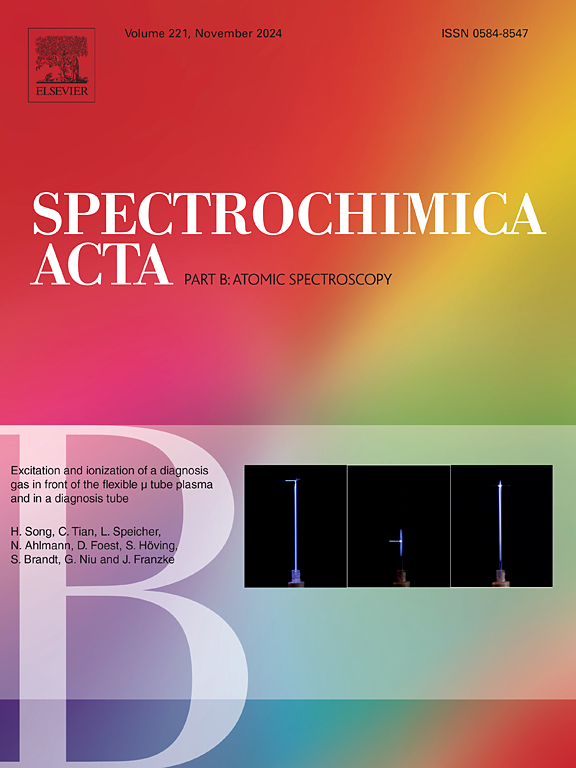LIBSFormer:通过精确和可解释的氧化物定量,增强火星原位LIBS数据分析
IF 3.8
2区 化学
Q1 SPECTROSCOPY
引用次数: 0
摘要
准确探测火星表面成分对于探索火星上的生命迹象至关重要。自2012年好奇号探测器登陆火星以来,激光诱导击穿光谱(LIBS)被广泛用于火星表面物质的原位分析。然而,用于LIBS数据定量分析的多变量方法面临着特征提取效率低、可解释性不足、泛化能力差等挑战。在本文中,我们提出了一种新的基于变压器的方法来定量分析LIBS数据中的氧化物,即LIBSFormer。LIBSFormer使用自关注机制来自动和整体地提取基本特征,在一个步骤中跨频谱关联信息。此外,我们提出了一种波长感知的标记化训练策略,以及一种元素驱动的模型选择方法,增强了模型的可解释性和可靠性。在ChemCam LIBS RDR数据集上的实验结果表明,LIBSFormer在火星原位LIBS数据的定量分析中表现出卓越的准确性和稳定性,优于最先进的方法。LIBSFormer的平均均方根误差(RMSE)为0.2199 wt%,标准差(SD)值为0.0177 wt%。与卷积神经网络(cnn)相比,LIBSFormer将RMSE降低了47.7%,SD降低了69.0%,在ChemCam校准数据集上取得了类似的结果。在可解释性方面,特征提取过程的关注权重表明,LIBSFormer能够有效地提取关键光谱线,准确率为90%。这些发现表明,LIBSFormer在火星原位LIBS数据的高精度定量分析中具有潜在的应用前景。本文章由计算机程序翻译,如有差异,请以英文原文为准。

LIBSFormer: Enhancing Mars in-situ LIBS data analysis with accurate and interpretable quantification of oxides
Accurate detection of the Martian surface composition is crucial for exploring signs of life on Mars. Since the Curiosity rover landed on Mars in 2012, Laser-Induced Breakdown Spectroscopy (LIBS) has been extensively utilized for in-situ analysis of Martian surface materials. However, multivariate methods employed for the quantitative analysis of LIBS data face challenges, including low feature extraction efficiency, insufficient interpretability, and poor generalizability. In this paper, we propose a novel Transformer-based approach for quantitative analysis of oxides in LIBS data, namely LIBSFormer. LIBSFormer employs the self-attention mechanism to automatically and holistically extract elemental features, associating information across the spectrum in a single step. Furthermore, we propose a wavelength-aware tokenization strategy for training, along with an element-driven approach for model selection, enhancing both model interpretability and reliability. The experimental results on the ChemCam LIBS RDR dataset demonstrate that LIBSFormer exhibits superior accuracy and stability in the quantitative analysis of Mars in-situ LIBS data, outperforming the state-of-the-art methods. The average Root Mean Square Error (RMSE) of LIBSFormer is 0.2199 wt%, with a Standard Deviation (SD) value of 0.0177 wt%. In comparison to the Convolutional Neural Networks (CNNs), LIBSFormer reduces the RMSE by 47.7 % and SD by 69.0 %, with similar results achieved on the ChemCam calibration dataset. With regard to interpretability, the attention weights of the feature extraction process have demonstrated that LIBSFormer is capable of effectively extracting key spectral lines with an accuracy of 90.0 %. These findings suggest that LIBSFormer has potential applications in high-accuracy quantitative analysis of Mars in-situ LIBS data.
求助全文
通过发布文献求助,成功后即可免费获取论文全文。
去求助
来源期刊
CiteScore
6.10
自引率
12.10%
发文量
173
审稿时长
81 days
期刊介绍:
Spectrochimica Acta Part B: Atomic Spectroscopy, is intended for the rapid publication of both original work and reviews in the following fields:
Atomic Emission (AES), Atomic Absorption (AAS) and Atomic Fluorescence (AFS) spectroscopy;
Mass Spectrometry (MS) for inorganic analysis covering Spark Source (SS-MS), Inductively Coupled Plasma (ICP-MS), Glow Discharge (GD-MS), and Secondary Ion Mass Spectrometry (SIMS).
Laser induced atomic spectroscopy for inorganic analysis, including non-linear optical laser spectroscopy, covering Laser Enhanced Ionization (LEI), Laser Induced Fluorescence (LIF), Resonance Ionization Spectroscopy (RIS) and Resonance Ionization Mass Spectrometry (RIMS); Laser Induced Breakdown Spectroscopy (LIBS); Cavity Ringdown Spectroscopy (CRDS), Laser Ablation Inductively Coupled Plasma Atomic Emission Spectroscopy (LA-ICP-AES) and Laser Ablation Inductively Coupled Plasma Mass Spectrometry (LA-ICP-MS).
X-ray spectrometry, X-ray Optics and Microanalysis, including X-ray fluorescence spectrometry (XRF) and related techniques, in particular Total-reflection X-ray Fluorescence Spectrometry (TXRF), and Synchrotron Radiation-excited Total reflection XRF (SR-TXRF).
Manuscripts dealing with (i) fundamentals, (ii) methodology development, (iii)instrumentation, and (iv) applications, can be submitted for publication.

 求助内容:
求助内容: 应助结果提醒方式:
应助结果提醒方式:


